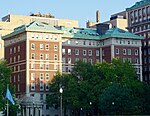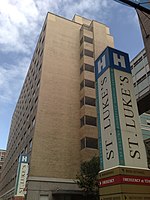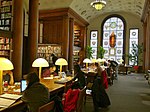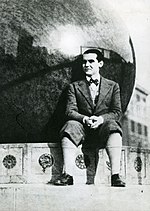John Howard Van Amringe (sculpture)
Busts in New York CityColumbia University campusMonuments and memorials in ManhattanNew York (state) sculpture stubsNew York City stubs ... and 3 more
Outdoor sculptures in ManhattanSculptures of men in New York CityVandalized works of art in New York City

John Howard Van Amringe, also known as the Van Amringe Memorial, is an outdoor bust depicting the American educator and mathematician of the same name, installed at Van Amringe Quadrangle on the Columbia University campus in Upper Manhattan, New York City. It was sculpted by William Ordway Partridge in 1912, and installed on Commencement Day in June 1922.On June 8, 1962, the bust was toppled off of its pedestal by vandals and received extensive damage. It was repaired or replaced, and reinstalled in December of that year.
Excerpt from the Wikipedia article John Howard Van Amringe (sculpture) (License: CC BY-SA 3.0, Authors, Images).John Howard Van Amringe (sculpture)
Amsterdam Avenue, New York Manhattan
Geographical coordinates (GPS) Address Website Nearby Places Show on map
Geographical coordinates (GPS)
| Latitude | Longitude |
|---|---|
| N 40.806342 ° | E -73.962037 ° |
Address
Van Amringe Memorial
Amsterdam Avenue
10115 New York, Manhattan
New York, United States
Open on Google Maps










